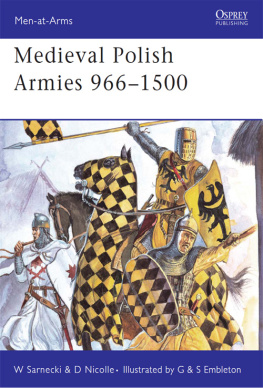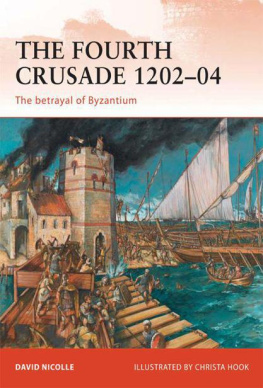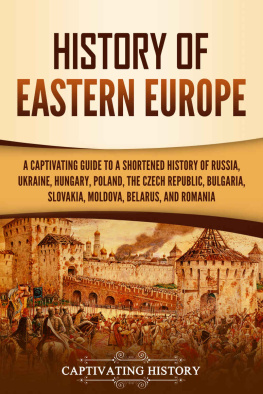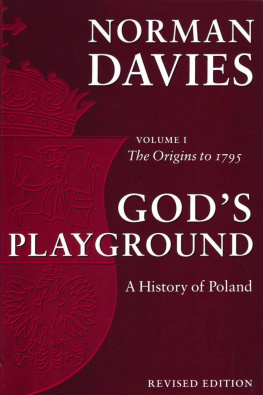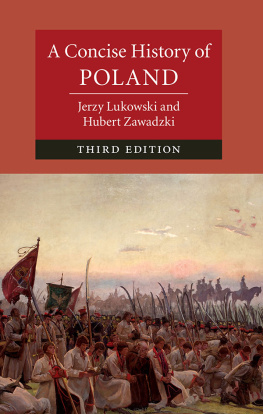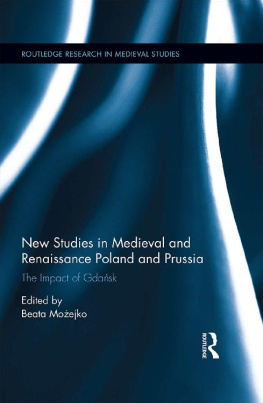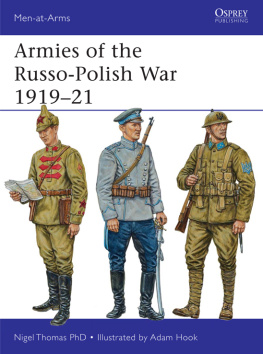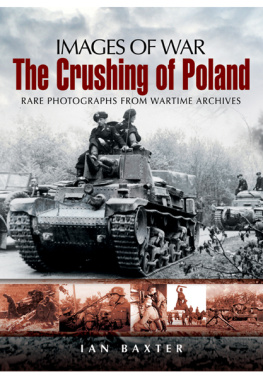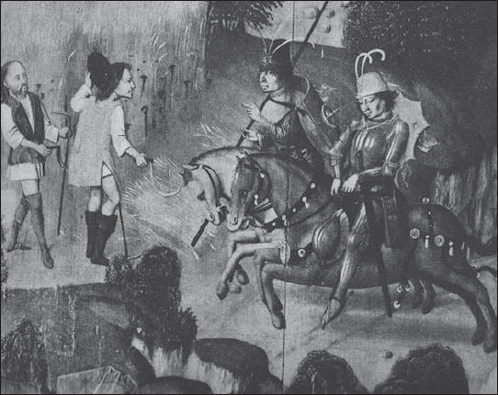Men-at-Arms 445
Medieval Polish Armies 9661500
W Sarnecki & D Nicolle Illustrated by G & S Embleton
Series editor Martin Windrow
WITOLD SARNECKI, born in Poland in 1974, gained his masters thesis in art history at Jagiellonian University, Cracow, in 1997, and specializes in historical military art. He currently lives in the town of Novy Sacz, where he catalogues artefacts for a monument preservation bureau and serves as a guide at the District Museum. This is his first contribution to Ospreys military list.
DAVID NICOLLE worked in the BBC Arabic service for a number of years, before going back to school, gaining an MA from the School of Oriental and African Studies, London, and a doctorate from Edinburgh University. He later taught world and Islamic art and architectural history at Yarmuk University, Jordan. He has been a prolific author of Osprey titles for many years.
GERRY EMBLETON is an internationally respected authority on military costume and material culture, in particular the 15th and 18th centuries. He has illustrated more than 40 Osprey titles. His company Time Machine AG has made 3D life sized historical figures for more than 60 museums world-wide. He and his son Samuel Embleton have collaborated on several works but this is Sams first Osprey title.
CONTENTS
The first Christian kingdom, 10th century
The Division in the Provinces, 12th14th centuries
MEDIEVAL POLISH ARMIES 9661500
HISTORICAL BACKGROUND
P OLAND BECAME A Christian country in AD 966, and in military terms the state was unified under the rule of Prince Mieszko I. However, the new kingdom was constantly threatened by numerous enemies, and consequently Mieszko and his successors were obliged to recognize the Western or German Emperors later known as the Holy Roman Emperors as their overlords. At the same time they often continued to find themselves in conflict with neighbouring German feudal lords, as well as with the Emperors themselves. Other foes during these early centuries included the pagan tribes of Pomerania; the Russians, including those now identified as Belarussians and Ukrainians; and the Bohemians (Czechs). Such conflicts were partly in defence of the newly formed Kingdom of Poland, and partly wars of conquest or expansion by the Poles themselves. In military terms this period was typified by units of professional household troops called the druzhina, who were supported during wartime by local militias or woye.
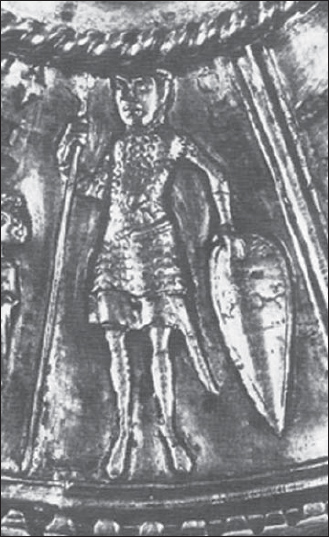
Detail from David and Goliath on an embossed chalice, dating from c.11751200. Note the sword passing through a slit in the left hip of the mail hauberk, and the kite-shaped shield. (Abbey of Tzemeszno)
The next period of Polish history is known as the Division in the Provinces, and lasted from 1138 to 1320. This long era of fragmentation was characterized by a decline of part-time militias in favour of professional or at least, better-trained household and local troops. It was upon these that the rulers of Poland now relied. It was also during this period, from the mid-12th to early 14th century, that a true Polish knightly class emerged as part of a gradually developing feudal system of government and social organization. Furthermore, in 115455 the crusading military orders the Hospitallers and Templars gained their first footholds on Polish soil. Later in this notably turbulent period the Teutonic Knights joined the older-established military orders, arriving on the scene in 1226, almost simultaneously with the foundation of the specifically Polish Brethren of Dobrzyn (Knights of Christ). Then came the Mongol invasions, with raids deep into Europe that culminated in the battle of Liegnitz/Legnica in 1241.
The 14th century saw the reunification of Poland under the rule of King Wladyslaw I Lokietek, known as the Short, and his son Casimir III, the Great. It also witnessed a growing threat from the Teutonic Knights, until the latter were defeated at the battle of Plowce in 1331. As a consequence of his relatively peaceful reign, King Casimir III went down in Polish history as one of the countrys greatest administrators and castle-builders; about 80 strongholds were constructed during his time.
In 1370 the still relatively small Kingdom of Poland was joined with the sprawling Angevin state in Central Europe, based upon the Kingdom of Hungary. This was, however, merely a personal union, that came about when King Louis of Hungary succeeded the childless Casimir the Great as ruler of Poland; it fell apart soon after Louis own death, there being little or no economic, political, ethnic or even strategic reason for its continuing existence.
The so-called Spear of St Maurice was given to Boleslaw I of Poland by Emperor Otto III of Germany in AD 1000. It is a simplified version of the so-called Holy Imperial Spear of the Western Empire. (Cathedral Treasury, Wawel, Cracow)
The Jagiello dynasty and union with Lithuania
There now followed one of the most significant events in medieval European history, when one of King Louis daughters, Jadwiga, was betrothed to the pagan Lithuanian Grand Duke Jogaila in 1386. Jogaila was baptized as a Christian, and his already huge Lithuanian state similarly became at least officially Christian in the process, Jogaila himself ruling as King Wladyslaw II Jagiello of Poland and Lithuania.
The history of later medieval Poland cannot be properly understood without looking at the history of its neighbour, rival and now partner Lithuania. This is equally true of later medieval Polish armies; these would develop to a large extent along highly distinctive lines, which set them apart from the military forces of Polands western and Baltic neighbours. The Mongol invasion and conquest of most of the Russian principalities in the 13th century, and their domination by the Mongol Golden Horde successor state, shattered the previous political and military order. This in turn enabled the small, largely pagan and in many respects still tribal Grand Duchy of Lithuania to expand at the expense of its Russian neighbours to the south-east, taking over several Russian principalities starting with Polotsk. This remarkable and still theoretically pagan expansion continued throughout the 14th century, eventually overrunning the whole of southern or Kievan Russia up to the frontier with the now declining Mongol Golden Horde. The once powerful Mongols were themselves pushed back in their turn, and by 1392 the Lithuanians had reached the north-western shores of the Black Sea. By that date, of course, the now vast Grand Duchy of Lithuania was a Christian state, and was six years into its union with emphatically Catholic Christian Poland. Nevertheless, the two united states continued to operate and function separately, only really joining forces to fight common foes such as the Teutonic Knights.
The 15th century was a period of significant change for medieval Polish armies, as it was for armies across most of Europe. The Teutonic Knights suffered a further and even more catastrophic defeat in 1410 at the battle of Tannenberg/Grunwald, where they were defeated by King Wladyslaw II Jagiello of Poland-Lithuania. The following year the Peace of Thorn/Torun ended what is known as The Great War against the Teutonic Order. Jagiellos son, Wladislaw III Warnenczyk, the young king of both Poland-Lithuania and Hungary, now focused the countrys military efforts to the east and south in an effort to combat Ottoman Turkish expansion; however, he was killed at the battle of Varna in 1444.

